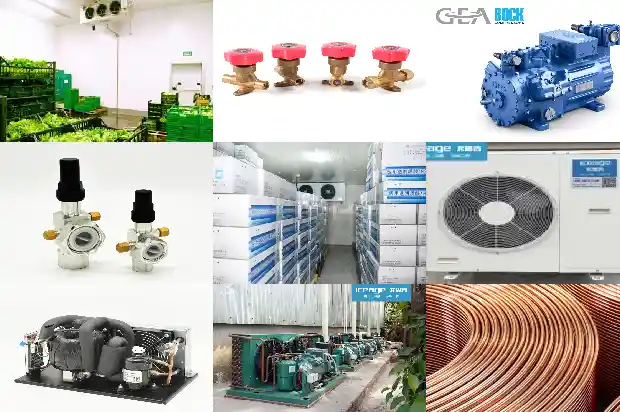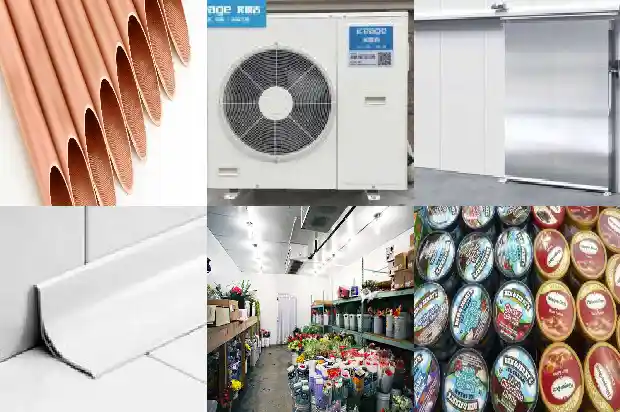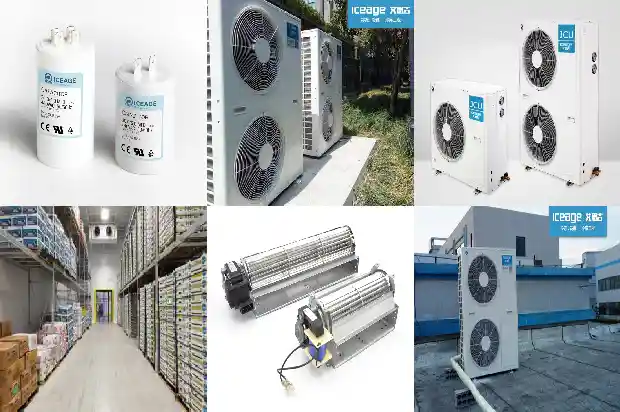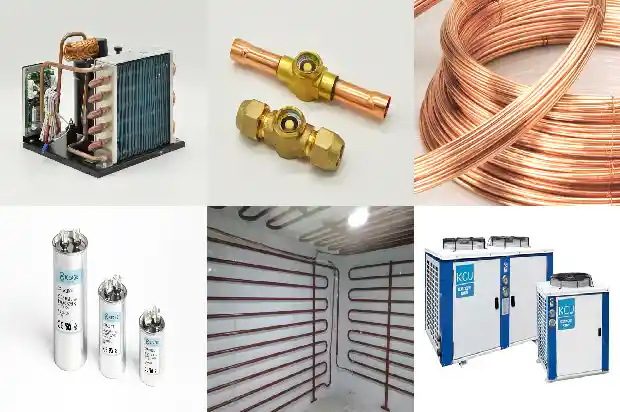Top Ten Components of Refrigeration Systems and Five Common Troubleshooting!
2024-12-20
I. Simple Refrigeration System Cycle
The four major components of the refrigeration system: compressor, condenser, throttling device, and evaporator.
The four major components of the refrigeration system: compressor, condenser, throttling device, and evaporator.
II. Functions of the Four Major Components:
Compressor - Adiabatic compression function: Compresses the refrigerant at medium-low temperature and low pressure into superheated steam at high temperature and high pressure.
Condenser - Condensation function (heat release): The gaseous refrigerant at high temperature and high pressure dissipates heat through heat exchange, and the refrigerant turns into a liquid at medium-high temperature and high pressure.
Throttling device - Throttling function: Through the throttling function, the liquid refrigerant at medium-high temperature and high pressure is transformed into the refrigerant in a gas-liquid two-phase state at low temperature and low pressure.
Evaporator - Evaporation function (heat absorption): The refrigerant absorbs heat when flowing through the evaporator. Through the function of the heat exchanger, the refrigerant is turned into a gaseous refrigerant at medium-low temperature and low pressure.
Compressor - Adiabatic compression function: Compresses the refrigerant at medium-low temperature and low pressure into superheated steam at high temperature and high pressure.
Condenser - Condensation function (heat release): The gaseous refrigerant at high temperature and high pressure dissipates heat through heat exchange, and the refrigerant turns into a liquid at medium-high temperature and high pressure.
Throttling device - Throttling function: Through the throttling function, the liquid refrigerant at medium-high temperature and high pressure is transformed into the refrigerant in a gas-liquid two-phase state at low temperature and low pressure.
Evaporator - Evaporation function (heat absorption): The refrigerant absorbs heat when flowing through the evaporator. Through the function of the heat exchanger, the refrigerant is turned into a gaseous refrigerant at medium-low temperature and low pressure.
III. Functions of Other Components:
High and Low Pressure Controller: It serves as a high-pressure and low-pressure protector for the refrigeration system. When the high pressure is too high or the low pressure is too low, an alarm signal will be generated.
Oil Separator: Separates the refrigerant and refrigeration oil in the exhaust pipe. The refrigerant continues to enter the condenser along the pipeline, while the separated refrigeration oil returns to the compressor through the oil return pipe.
Condensing Pressure Regulating Valve: It plays a role in regulating the condensing pressure, which can prevent the high-pressure protection caused by excessive condensing pressure and also prevent the insufficient pressure difference before and after the throttling structure due to too low condensing pressure. Of course, not every system needs this valve, and there will be a special course to explain it later.
Receiver: Stores the excess refrigerant in the refrigeration system.
Some colleagues may ask: Since there is too much refrigerant in the refrigeration system, can't we just release it directly? Is it necessary to set up a receiver specifically to store it?
Answer: The load of the refrigeration system is not a constant value. For example, under low-temperature working conditions, the refrigerant circulating in the refrigeration system will be far less than that under normal temperature working conditions. At this time, if there is no receiver, the excess refrigerant will be stored in the condenser, occupying most of the heat exchange area.
Ball Valve: It is a manually opened and closed valve that can cut off the refrigerant circuit.
Many people think that this ball valve is useless and completely redundant. Here, I will briefly introduce several of its functions:
High and Low Pressure Controller: It serves as a high-pressure and low-pressure protector for the refrigeration system. When the high pressure is too high or the low pressure is too low, an alarm signal will be generated.
Oil Separator: Separates the refrigerant and refrigeration oil in the exhaust pipe. The refrigerant continues to enter the condenser along the pipeline, while the separated refrigeration oil returns to the compressor through the oil return pipe.
Condensing Pressure Regulating Valve: It plays a role in regulating the condensing pressure, which can prevent the high-pressure protection caused by excessive condensing pressure and also prevent the insufficient pressure difference before and after the throttling structure due to too low condensing pressure. Of course, not every system needs this valve, and there will be a special course to explain it later.
Receiver: Stores the excess refrigerant in the refrigeration system.
Some colleagues may ask: Since there is too much refrigerant in the refrigeration system, can't we just release it directly? Is it necessary to set up a receiver specifically to store it?
Answer: The load of the refrigeration system is not a constant value. For example, under low-temperature working conditions, the refrigerant circulating in the refrigeration system will be far less than that under normal temperature working conditions. At this time, if there is no receiver, the excess refrigerant will be stored in the condenser, occupying most of the heat exchange area.
Ball Valve: It is a manually opened and closed valve that can cut off the refrigerant circuit.
Many people think that this ball valve is useless and completely redundant. Here, I will briefly introduce several of its functions:
- It can be used to close the refrigerant in the condenser or receiver when replacing the filter or thermal expansion valve, so that it is not necessary to release the refrigerant of the entire system.
- Adding refrigerant to the system: During the commissioning of a new machine, the refrigerant cannot be completely added when the machine is shut down. At this time, it is necessary to start the compressor and suck the refrigerant into the system through the suction pipe of the compressor. However, under many normal temperature working conditions, the pressure in the evaporator is actually not low or even higher than the pressure in the refrigerant tank, and the refrigerant cannot be added either. At this time, we can close this ball valve, switch the refrigerant from the condensing side, and the compressor can suck the refrigerant into the system.
- Adding refrigeration oil to the system: Many colleagues will consult in the group about how to add refrigeration oil. Some colleagues suggest injecting refrigeration oil into the system with an oil gun, which is actually completely unnecessary. When the compressor is started, close the ball valve. At this time, the low pressure will gradually decrease. Before it approaches the atmospheric pressure, put the refrigerant charging pipe into the refrigeration oil bottle. When the pressure gradually drops below the atmospheric pressure, the refrigeration oil will be sucked into the refrigeration system by the suction force of the compressor.
- Recovering refrigerant.
Drier Filter: As the name implies, it plays a role in removing moisture and filtering impurities in the refrigeration system. It is installed in front of the expansion valve to prevent impurities from entering the valve core and blocking the expansion valve.
Solenoid Valve: It is an electrically driven component that can manually or automatically cut off the refrigeration pipeline. It also plays a significant role in the refrigeration system. You can refer to the functions of the ball valve, and we won't repeat them here.
Evaporation Pressure Regulating Valve: It mainly prevents the evaporation pressure from being too high, which may lead to compressor failure.
Crankcase Pressure Regulating Valve: It can also be called the suction pressure regulating valve, which prevents the compressor from being damaged due to excessive suction pressure resulting in too high a load on the compressor.
The evaporation pressure regulating valve and the crankcase pressure regulating valve are not required for every system. Generally, for small systems, we can use a thermal expansion valve with the MOP function to replace them.
Suction Filter: Installed on the suction pipe, it filters the impurities in the refrigeration system to prevent them from entering the compressor and causing compressor failure.
The above is the principle of the refrigeration cycle and the functions of each component. Later, we will explain the structure and function of each component one by one in video courses. Please stay tuned!
IV. Five Common Faults in the Refrigeration System
I. Treatment of Refrigerant Deficiency
I. Treatment of Refrigerant Deficiency
- Fault Phenomenon:
The refrigeration effect of the whole unit is poor. The water outlet is only a little cool. When checked with a manifold pressure gauge, it is found that the pressures on both the high-pressure side and the low-pressure side are low (when the compressor rotates at a normal speed and the ambient temperature is about 35 °C, the index of the low-pressure gauge is lower than 1 kg/cm², and the index of the high-pressure gauge is lower than 10 kg/cm²). Meanwhile, bubbles can be seen flowing in the sight glass. - Fault Cause:
There are refrigerant leakage points in the refrigeration system, resulting in insufficient refrigerant. - Treatment Methods:
- Use an electronic leak detector to find the leakage points and repair or replace the components.
- If the components are not replaced, just supplement an appropriate amount of refrigerant. If the components are replaced, an appropriate amount of refrigeration oil should be added as required, and the system should be evacuated and then filled with sufficient refrigerant.
II. Excessive Refrigerant Charge
- Fault Phenomenon:
The refrigeration effect is poor. When checked with a manifold pressure gauge, it is found that the pressures on both the high-pressure side and the low-pressure side are too high (when the compressor rotates at a normal speed and the ambient temperature is 35 °C, the pressure on the high-pressure gauge is about 19 kg/cm², and the pressure on the low-pressure gauge is 2.3 kg/cm², and no bubbles are seen flowing in the sight glass).
- Fault Cause:
Too much refrigerant is injected into the refrigeration system, so that the refrigeration capacity cannot be fully utilized, resulting in a poor refrigeration effect. - Treatment Methods:
Connect a manifold pressure gauge to the system, slowly loosen the manual valve on the low-pressure side of the manifold pressure gauge to let the refrigerant discharge slowly (do not discharge from the high-pressure side, because discharging refrigerant from the high-pressure side will bring out a large amount of refrigeration oil) until the pressures on both the high and low sides are normal. Meanwhile, clear flow of the refrigerant can be seen in the sight glass, and occasionally bubbles flow through.
III. Air Mixed in the Refrigeration System
- Fault Phenomenon:
The refrigeration capacity of the whole unit decreases. When checked with a manifold pressure gauge, it is found that the pressure on the high-pressure side is relatively high, and the pressure on the low-pressure side is sometimes higher than the normal value (when the compressor rotates at a normal speed and the ambient temperature is 35 °C, the pressure on the high-pressure side is higher than 20 kg/cm²; and the pointer of the high-pressure gauge swings; on the other hand, many bubbles can be seen flowing in the sight glass). - Fault Cause:
Air is mixed into the system. Mainly, the vacuum pumping is not thorough after assembly or overhaul. When injecting refrigerant or adding refrigeration oil, air is brought into the system, or when the system works under negative pressure, air is mixed in through the unsealed parts. After air enters the refrigerant, it has a certain pressure, and the refrigerant also has a certain pressure. In a closed container, the total gas pressure is equal to the sum of the partial pressures, so the readings of both the high and low pressure gauges are higher than the normal values. - Treatment Methods:
- Release the refrigerant (slowly release it from the low-pressure side with a pressure gauge).
- Check the cleanliness of the compressor oil.
- Evacuate the system and then refill the refrigerant.
IV. "Ice Blockage" in the Refrigeration System
- Fault Phenomenon:
The refrigeration system periodically refrigerates and then stops refrigerating. During the operation process, the pointer of the low-pressure side on the manifold pressure gauge often fluctuates between negative pressure and the normal value. - Fault Cause:
Moisture is mixed into the refrigerant in the refrigeration system. Since moisture and refrigerant are immiscible, when the refrigerant flows through the throttling orifice of the expansion valve, the temperature drops suddenly. The moisture mixed in the refrigerant easily forms small ice particles around the throttling valve orifice or the valve needle orifice, which are spherical or hemispherical. When the ice particles accumulate to a certain extent, they block the throttling channel, forming an ice blockage fault. After ice forms and blocks, the refrigeration system cannot work normally, and the refrigeration effect is significantly reduced or even disappears.
At this time, the low-pressure gauge shows negative pressure. Then the temperature at the ice blockage point obviously rises, the ice particles melt into water, the ice blockage phenomenon disappears, the refrigeration system resumes normal work, refrigerates well, and the low-pressure side pressure returns to normal. After a while, the system has ice blockage again and works abnormally. - Treatment Methods:
- Since the desiccant is in a supersaturated state, the receiver with desiccant must be replaced and 30 ml of refrigeration oil should be added.
- Evacuate the system and add the specified amount of refrigerant.
V. Troubleshooting of Dirty Blockage
- Fault Phenomenon:
The refrigeration effect is poor or there is no refrigeration. When the air-conditioning system is running, the readings of both the high-pressure and low-pressure gauges on the manifold pressure gauge are lower than the normal values (when the compressor rotates at a normal speed and the ambient temperature is about 35 °C, the pressure on the high-pressure gauge side is lower than 9 kg/cm², and the pressure on the low-pressure gauge side is in a negative pressure state), and there is frost or dew on the pipelines before and after the filter and capillary tube. - Fault Cause:
Dust in the refrigeration system adheres or attaches to the filter screen at the inlet end of the filter or the interface between the capillary tube and the filter screen, causing a local throttling phenomenon at this position, and the temperature drops rapidly, resulting in frost or dew. - Treatment Methods:
- If there is frost at the inlet of the filter and intermittent air flow sounds can be heard, gently tap the filter body with a small wrench. If the air flow sound changes and the frost layer in front of the filter and capillary tube melts, it can be judged that the filter inlet screen is blocked.
At this time, you should:
① Remove the capillary tube, clean the filter screen and dry it, and then reinstall it.

Or replace the filter.
② Evacuate the system and inject the refrigerant to the specified amount.
Related Articles
- Principles, Components and Heat Recovery of Modular Units
- Basic Knowledge of Valve - type Components in Refrigeration Systems (Technical Sharing)
- Analysis of 6 Components in Air - cooled Multi - split Systems
- Analysis of Advantages, Disadvantages and 34 Common Components of Multi - split Air Conditioners
- Are you familiar with the detection and maintenance methods of air conditioner components?
- Refrigeration System Circulation and Components for Freezing and Cold Storage
- Principles of Refrigeration Systems and Functions of Components Explained
- Defrosting Operation Modes of Refrigeration Equipment and Its Control Components
- Refrigeration System Components and Common Failures
- Structural Components of Centrifugal Compressor
- The Structure and Components of Centrifugal Compressors
- Introduction to the Components of a Cold Storage Unit and Common Issues in Cold Storage Units
- Water-cooled Split Air Conditioner Unit: Components and Installation
- Have You Encountered the Three Common Problems of Refrigeration Compressors?
- How to Calculate Refrigeration Load? And What Are the Issues?
- What to Do if the Compressor of a Frozen and Refrigerated Display Cabinet Runs but the Refrigeration Effect Is Poor?
- Instructions for Welding and Drainage in the Installation of Refrigeration Equipment Pipelines
- Common Pressure Valves and Protection Devices in Refrigeration Units
